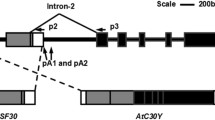Abstract
Precursor-mRNAs (pre-mRNA) can be processed into one or more mature mRNA isoforms through constitutive or alternative splicing pathways. Constitutive splicing of pre-mRNA plays critical roles in gene expressional regulation, such as intron-mediated enhancement (IME), whereas alternative splicing (AS) dramatically increases the protein diversity and gene functional regulation. However, the unavailability of mutants for individual spliced isoforms in plants has been a major limitation in studying the function of mRNA splicing. Here, we describe an efficient tool for manipulating the splicing of plant genes. Using a Cas9-directed base editor, we converted the 5′ splice sites in four Arabidopsis genes from the activated GT form to the inactive AT form. Silencing the AS of HAB1.1 (encoding a type 2C phosphatase) validated its function in abscisic acid signaling, while perturbing the AS of RS31A revealed its functional involvement in plant response to genotoxic treatment for the first time. Lastly, altering the constitutive splicing of Act2 via base editing facilitated the analysis of IME. This strategy provides an efficient tool for investigating the function and regulation of gene splicing in plants and other eukaryotes.
Similar content being viewed by others
References
Barta, A., Kalyna, M., and Reddy, A.S.N. (2010). Implementing a rational and consistent nomenclature for serine/arginine-rich protein splicing factors (SR proteins) in plants. Plant Cell 22, 2926–2929.
Burset, M. (2001). SpliceDB: database of canonical and non-canonical mammalian splice sites. Nucleic Acids Res 29, 255–259.
Chen, Y., Wang, Z., Ni, H., Xu, Y., Chen, Q., and Jiang, L. (2017). CRISPR/Cas9-mediated base-editing system efficiently generates gainof-function mutations in Arabidopsis. Sci China Life Sci 60, 520–523.
Chorev, M., and Carmel, L. (2012). The function of introns. Front Gene 3, 55.
Filichkin, S.A., Priest, H.D., Givan, S.A., Shen, R., Bryant, D.W., Fox, S. E., Wong, W.K., and Mockler, T.C. (2010). Genome-wide mapping of alternative splicing in Arabidopsis thaliana. Genome Res 20, 45–58.
Jeong, Y.M., Jung, E.J., Hwang, H.J., Kim, H., Lee, S.Y., and Kim, S.G. (2009). Roles of the first intron on the expression of Arabidopsis (Arabidopsis thaliana) genes for actin and actin-binding proteins. Plant Sci 176, 58–65.
Kang, B.C., Yun, J.Y., Kim, S.T., Shin, Y.J., Ryu, J., Choi, M., Woo, J.W., and Kim, J.S. (2018). Precision genome engineering through adenine base editing in plants. Nat Plants 4, 427–431.
Laxa, M. (2016). Intron-mediated enhancement: a tool for heterologous gene expression in plants? Front Plant Sci 7, 1977.
Li, J., Sun, Y., Du, J., Zhao, Y., and Xia, L. (2017). Generation of targeted point mutations in rice by a modified CRISPR/Cas9 system. Mol Plant 10, 526–529.
Lu, Y., and Zhu, J.K. (2017). Precise editing of a target base in the rice genome using a modified CRISPR/Cas9 system. Mol Plant 10, 523–525.
Maniatis, T., and Reed, R. (1987). The role of small nuclear ribonucleoprotein particles in pre-mRNA splicing. Nature 325, 673–678.
Ner-Gaon, H., Halachmi, R., Savaldi-Goldstein, S., Rubin, E., Ophir, R., and Fluhr, R. (2004). Intron retention is a major phenomenon in alternative splicing inArabidopsis. Plant J 39, 877–885.
Nishida, K., Arazoe, T., Yachie, N., Banno, S., Kakimoto, M., Tabata, M., Mochizuki, M., Miyabe, A., Araki, M., Hara, K.Y., et al. (2016). Targeted nucleotide editing using hybrid prokaryotic and vertebrate adaptive immune systems. Science 353, 1206–1207.
Reddy, A.S.N., Marquez, Y., Kalyna, M., and Barta, A. (2013). Complexity of the alternative splicing landscape in plants. Plant Cell 25, 3657–3683.
Ren, B., Yan, F., Kuang, Y., Li, N., Zhang, D., Lin, H., and Zhou, H. (2017). A CRISPR/Cas9 toolkit for efficient targeted base editing to induce genetic variations in rice. Sci China Life Sci 60, 516–519.
Shapiro, M.B., and Senapathy, P. (1987). RNA splice junctions of different classes of eukaryotes: sequence statistics and functional implications in gene expression. Nucl Acids Res 15, 7155–7174.
Shaul, O. (2017). How introns enhance gene expression. Int J Biochem Cell Biol 91, 145–155.
Staiger, D., and Brown, J.W.S. (2013). Alternative splicing at the intersection of biological timing, development, and stress responses. Plant Cell 25, 3640–3656.
von Arnim, A.G., Jia, Q., and Vaughn, J.N. (2014). Regulation of plant translation by upstream open reading frames. Plant Sci 214, 1–12.
Wang, B.B., and Brendel, V. (2006). Genomewide comparative analysis of alternative splicing in plants. Proc Natl Acad Sci USA 103, 7175–7180.
Wang, Z., Ji, H., Yuan, B., Wang, S., Su, C., Yao, B., Zhao, H., and Li, X. (2015). ABA signalling is fine-tuned by antagonistic HAB1 variants. Nat Commun 6, 8138.
Zhan, X., Qian, B., Cao, F., Wu, W., Yang, L., Guan, Q., Gu, X., Wang, P., Okusolubo, T.A., Dunn, S.L., et al. (2015). An Arabidopsis PWI and RRM motif-containing protein is critical for pre-mRNA splicing and ABA responses. Nat Commun 6, 8139.
Zhang, H., Si, X., Ji, X., Fan, R., Liu, J., Chen, K., Wang, D., and Gao, C. (2018). Genome editing of upstream open reading frames enables translational control in plants. Nat Biotechnol 36, 894–898.
Zong, Y., Wang, Y., Li, C., Zhang, R., Chen, K., Ran, Y., Qiu, J.L., Wang, D., and Gao, C. (2017). Precise base editing in rice, wheat and maize with a Cas9-cytidine deaminase fusion. Nat Biotechnol 35, 438–440.
Acknowledgements
This work was supported by grants from the National Key Research and Development Program of China (2016YFD0101804), the National Natural Science Foundation of China (31788103 and 31420103912), as well as the Chinese Academy of Sciences (QYZDY-SSW-SMC030 and GJHZ1602).
Author information
Authors and Affiliations
Corresponding author
Electronic supplementary material
Rights and permissions
About this article
Cite this article
Xue, C., Zhang, H., Lin, Q. et al. Manipulating mRNA splicing by base editing in plants. Sci. China Life Sci. 61, 1293–1300 (2018). https://doi.org/10.1007/s11427-018-9392-7
Received:
Accepted:
Published:
Issue Date:
DOI: https://doi.org/10.1007/s11427-018-9392-7




